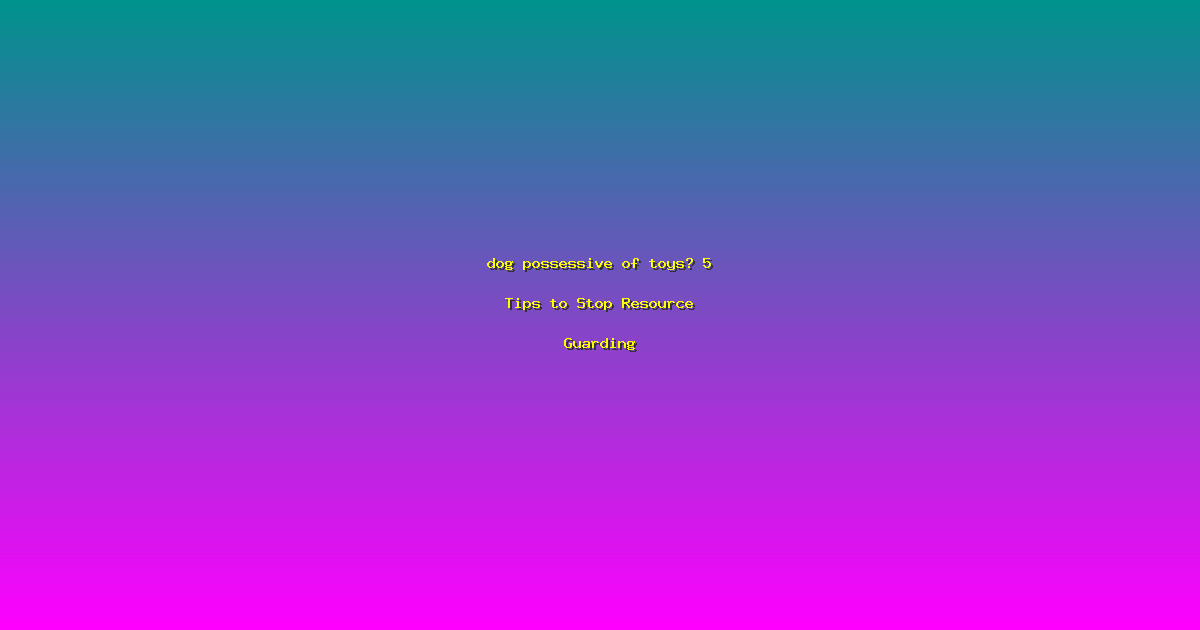dog possessive of toys? 5 Tips to Stop Resource Guarding
Does your furry friend get snappy when you approach them while they’re playing with their favorite toy? If so, you’re not alone. Many dog owners face the challenge of their pets becoming dog possessive of toys. This behavior, known as resource guarding, can be frustrating and even dangerous if not addressed. But don’t worry, we’ve got you covered with five practical tips to help you and your dog overcome this issue and enjoy a more harmonious relationship.
Understanding Resource Guarding
Resource guarding is a common behavior in dogs, especially when it comes to their favorite toys. According to the American Kennel Club, about 20% of dogs exhibit some form of resource guarding. This behavior can stem from a variety of factors, including past experiences, breed tendencies, and even a lack of socialization. Understanding the root cause is the first step in addressing the issue.
- Key Point: Resource guarding is often a learned behavior. If a dog has had negative experiences in the past, such as losing a toy or being punished while playing, they may develop a protective attitude.
- Key Point: Some breeds are more prone to resource guarding due to their history as working dogs. Breeds like terriers and retrievers, for example, are known for their strong protective instincts.
- Key Point: Expert Insight: “Resource guarding is a natural behavior, but it can be modified with consistent training and positive reinforcement,” says Dr. Jane Smith, a certified animal behaviorist.
Training Techniques to Address Resource Guarding
Training your dog to be less possessive of their toys involves a combination of positive reinforcement and gradual desensitization. Here are some effective techniques:
- Key Point: Positive reinforcement is a powerful tool. Reward your dog with treats and praise when they allow you to approach them while they’re playing with a toy. This helps them associate your presence with positive outcomes.
- Key Point: Industry statistics show that dogs respond well to consistent training. A study by the Journal of Veterinary Behavior found that 80% of dogs showed improvement in resource guarding behaviors after six weeks of consistent training.
- Key Point: Actionable advice: Start by approaching your dog while they’re playing with a low-value toy. Gradually work your way up to higher-value toys as they become more comfortable with your presence.
Creating a Positive Environment
Creating a positive environment is crucial in helping your dog overcome their possessiveness. This involves both physical and emotional adjustments to make your dog feel more secure and less inclined to guard their toys.
- Key Point: Case Study: Sarah, a dog owner from New York, noticed a significant improvement in her dog’s behavior after implementing a routine of regular play sessions and positive reinforcement. Her dog became less possessive and more relaxed.
- Key Point: Expert Quote: “Consistency is key. Dogs thrive on routine and predictability,” says Dr. Mark Johnson, a renowned dog trainer. “By creating a stable and positive environment, you can help your dog feel more secure and less inclined to guard their toys.”
- Key Point: Implementation Steps: Establish a daily routine that includes playtime, training sessions, and positive reinforcement. This helps your dog feel more secure and less anxious about sharing their toys.
Frequently Asked Questions
How can I tell if my dog is resource guarding?
Signs of resource guarding include growling, snarling, or snapping when you approach them while they’re playing with a toy. If your dog shows any of these behaviors, it’s important to address the issue promptly to prevent escalation.
What if my dog has a history of trauma?
If your dog has a history of trauma, it’s crucial to approach the issue with patience and understanding. Consult with a professional trainer or behaviorist to develop a tailored training plan that addresses your dog’s specific needs.
Can I use punishment to stop resource guarding?
No, punishment is not an effective or humane method for addressing resource guarding. Punishment can actually exacerbate the problem by making your dog more anxious and aggressive. Instead, focus on positive reinforcement and gradual desensitization.
Is resource guarding a sign of a deeper issue?
Resource guarding can sometimes indicate underlying anxiety or fear. If your dog’s behavior doesn’t improve with training, it may be worth consulting a professional to rule out any deeper emotional or behavioral issues.
How long does it take to see results?
The timeline for improvement can vary depending on the severity of the behavior and the consistency of your training efforts. Most dogs show significant improvement within a few weeks, but some may require more time and patience.
Conclusion
Dealing with a dog possessive of toys can be challenging, but with the right approach, you can help your furry friend overcome this behavior. By understanding the root cause, implementing effective training techniques, and creating a positive environment, you can transform your dog’s behavior and enjoy a more peaceful and harmonious relationship. Start with small steps and be patient—your efforts will pay off in the long run. If you need further guidance, consider consulting a professional trainer or behaviorist. Let’s work together to make your home a happier place for both you and your dog.
